What happened in Syria so far?
A detailed summary of what happened in Syria since its inception
Sorry for the annoying ads this is how I earn money :(
First where is Syria?
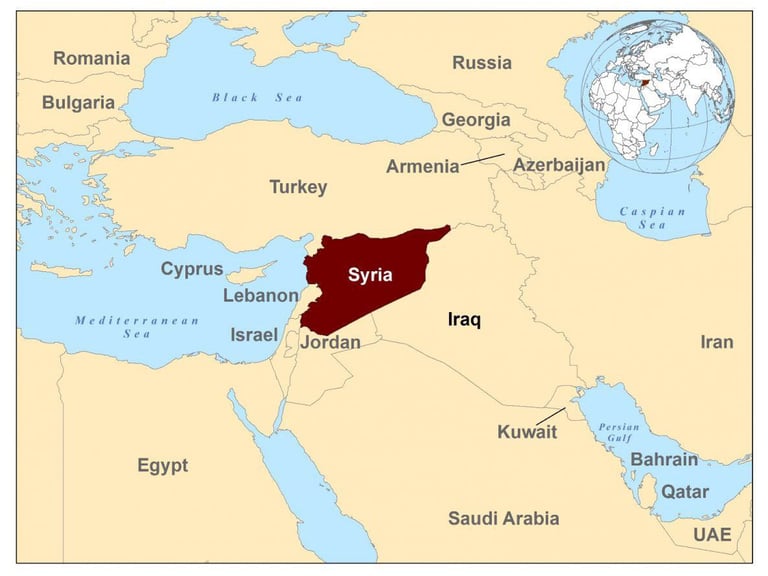

Syria is located in the Levant (Bilad Al-Sham) region of Middle East on the east coast of the Mediterranean Sea bordering Turkey to the north, Iraq to the east and southeast, Jordan to the south, Lebanon to the southwest and Israel to the southwest.
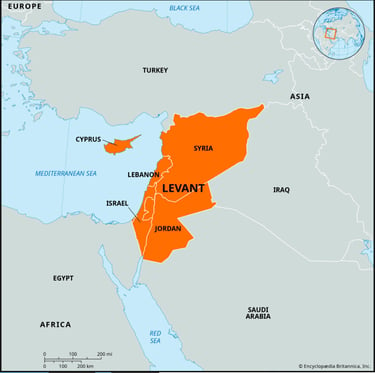

A little bit Syrian history
Syria as a modern day country didn't exist before 1916. Syria was known as the broader Levantine region by the Greeks that extended from Anatolia to Egypt. The region has a rich and tumultuous history that dates back to its establishment in ancient times. It is one of the oldest regions of human civilization. By 3000 BCE, it was part of the ancient Mesopotamian, Egyptian, and Levantine worlds. The very first empire that ruled parts of the Syrian region(Levantine) was the Kingdom of Ebla (ca. 2500 BCE). Syria was home to some of the world's earliest cities and cultures, including the Sumerians and the Phoenicians. Over the centuries, various empires have ruled this strategic territory, including the Akkadians, Assyrians, Babylonians, Persians, Greeks, and Romans. The region was later part of the Islamic Caliphates, and in the Ottoman era, it became a significant province. However, the 20th century brought about dramatic changes, with Syria gaining independence from France in 1946. More recently, the country has suffered through a brutal civil war that began in 2011, leading to widespread devastation and the ongoing struggle against the Kurdish separatist after the fall of Bashar al-Assad regime.
Throughout its history, Syria was controlled by many empires:
1. Akkadian Empire (ca. 2330–2150 BCE)
2. Amorite Kingdoms (ca. 2000–1600 BCE)
3. Hittites (ca. 1600–1200 BCE)
4. Neo-Assyrian Empire (ca. 911–609 BCE)
5. Neo-Babylonian Empire (ca. 626–539 BCE)
6. Achaemenid Persian Empire (ca. 539–332 BCE)
7. Macedonian Empire under Alexander the Great (ca. 332–323 BCE)
8. Seleucid Empire (ca. 312–63 BCE)
9. Roman Empire (ca. 63 BCE–395 CE)
10. Byzantine Empire (ca. 395–636 CE)
11. Rashidun Caliphate (ca. 636–661 CE)
12. Umayyad Caliphate (661–750 CE) – Capital: Damascus
13. Abbasid Caliphate (750–1258 CE)
14. Fatimid Caliphate (969–1171 CE, partial control)
15. Crusader States (1098–1187 CE, partial control)
16. Ayyubid Dynasty (1171–1250 CE)
17. Mamluk Sultanate (1250–1517 CE)
18. Ottoman Empire (1516–1918 CE)
The Partition of Ottoman Empire
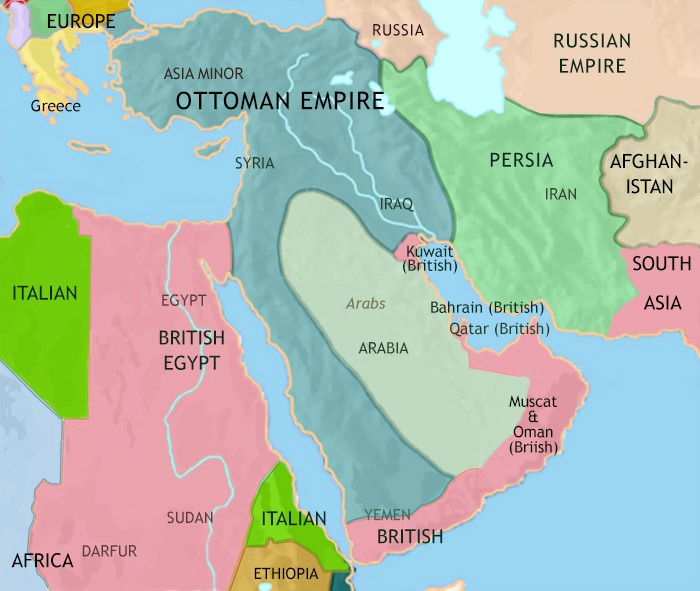

The Sykes-Picot Agreement (1916)
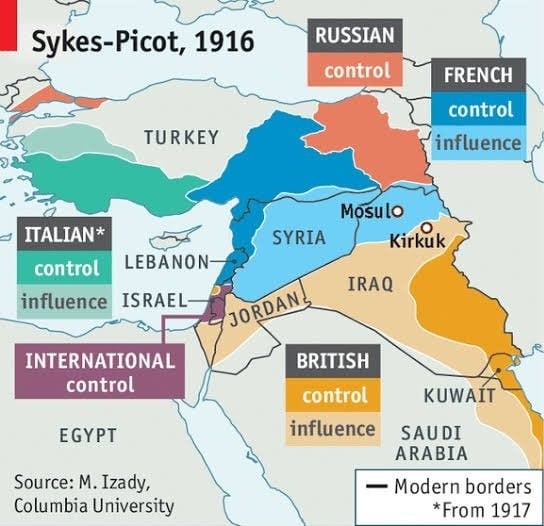

Middle East
Levant (Bilad Al-Sham)
Syria along with the whole Levant region was under the control of the Ottoman empire until the Ottomans decided to participate in WW1 and form an alliance with The Central Power. The Central Powers led by Germany, Austria-Hungary, Bulgaria, and the Ottoman Empire, were defeated by the Allies(Led by France, Russia, the British Empire, Italy, and the United States). The Ottoman empire suffered a significant defeat. The huge conglomeration of territories and peoples that formerly comprised the Ottoman Empire was divided into several new states.
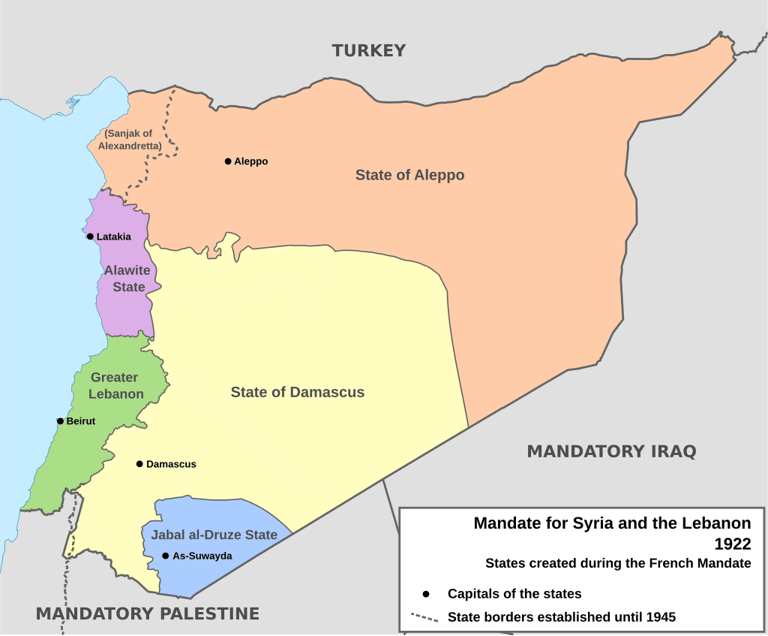

French Mandate
In secret negotiations, Britain and France (with Russia's assent) signed the Sykes-Picot Agreement to divide Ottoman territories in the Middle East into spheres of influence.
France was promised Syria and Lebanon.
Britain was allocated Iraq, Transjordan, and Palestine.
The Arab Revolt (1916)
The British encouraged Arab leaders to revolt against the Ottomans, promising independence for Arab lands. In 1916, Sharif Hussein of Mecca launched the Arab Revolt with the help of figures like T.E. Lawrence ("Lawrence of Arabia"). However, the promises of Arab independence conflicted with the Sykes-Picot Agreement.
End of World War I and the Paris Peace Conference (1919)
After the Ottoman defeat in 1918, Arab forces, led by Emir Faisal (Sharif Hussein’s son), entered Damascus and proclaimed an independent Arab kingdom. Faisal sought international recognition at the Paris Peace Conference, but the Allied powers dismissed Arab claims.
San Remo Conference (1920)
The Allied powers formalized the division of Ottoman territories at the San Remo Conference. France was awarded a mandate over Syria and Lebanon under the newly formed League of Nations.
French Military Intervention (1920)
Emir Faisal had established a short-lived Arab Kingdom of Syria in 1920, with Damascus as its capital. However, France opposed this move. In July 1920, French forces defeated Faisal’s army at the Battle of Maysalun and took control of Damascus. Faisal was forced into exile.
French Mandate (1920–1946)
France formally established its mandate over Syria and Lebanon, splitting Syria into smaller administrative units to weaken national unity and create divisons and chaos among different religious sects and ethnic groups in the region. These included Damascus, Aleppo, and autonomous regions for the Alawites and Druze. The French faced significant resistance, including revolts like the Great Syrian Revolt (1925–1927). Syria remained under French control until its independence in 1946, following World War II and international pressure.
After Independence
Coups and Arab-Israeli War(1946–1954)
Syria experienced frequent changes in government, with numerous coups and shifts in leadership. In 1949 alone, three coups occurred, beginning with the overthrow of President Shukri al-Quwatli by General Husni al-Za'im. Efforts to establish a stable democratic system were undermined by military interference and factionalism created by French Mandate. Syria opposed the creation of Israel in 1948 and participated in the Arab-Israeli War, suffering military defeats. Refugees from Palestine arrived in large numbers, straining resources.
Creation of United Arab Republic(1954–1958)
Military leaders played an increasingly dominant role in politics. The Arab Socialist Ba'ath Party, founded in the 1940s, gained traction by promoting Arab unity, socialism, and resistance to Western imperialism. In 1958, Syria merged with Egypt under President Gamal Abdel Nasser to form the United Arab Republic (UAR). The union was driven by Arab nationalist sentiment and fear of Western influence in the region.
The Break-Up of United Arab Republic (1958–1961)
The union centralized power in Cairo, marginalizing Syrian political leaders and causing discontent. Economic policies imposed by Egypt alienated Syrian elites. In 1961, Syrian officers staged a coup, dissolving the UAR and reestablishing Syria as an independent state.
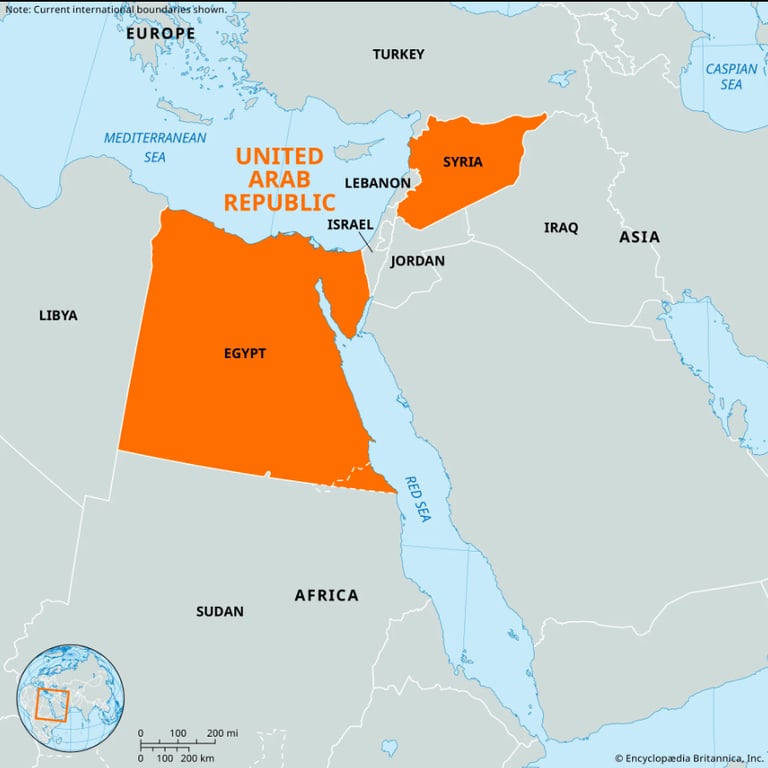

United Arab Republic
Ba'athist Party and Radicalization (1963–1970)
Although Ba'ath party was founded in 1947 by Michel Aflaq(Christian), Salah a-Din al-Bitar(Sunni) and Zaki al-Arsuzi(Alawite) the Ba'ath Party only came into power via a military coup in 1963, marking the beginning of its long rule in Syria. The Ba'ath government implemented land reforms, nationalized industries, and promoted state-led economic development. The Ba'ath Party was plagued by ideological and factional divisions, leading to further instability.
Rise of Hafez al-Assad (1970)
Hafez al-Assad, then Minister of Defense under the Ba'ath Party government, staged the coup Movement in 1970 against Salah Jadid(de facto leader of Syria) and became the Prime Minister. Assad was elected President in a controlled referendum, officially consolidating his authority. He established an authoritarian regime underpinned by the Ba'ath Party and the military, ushering in a period of stability but also repression. He died in office in 2000 after ruling Syria for 30 years as a dictator and soon after his son Bashar al-Assad become the new President(or dictator) without any election.
Syrian Civil War
In March 2011, popular discontent with the rule of Bashar al-Assad triggered large-scale protests and pro-democracy rallies across Syria, as part of the wider Arab Spring protests in the region. The Syrian government, led by Bashar al-Assad, responded to the protests with brutal force, deploying the military and security services to suppress dissent. This crackdown led to the militarization of the opposition, and by mid-2011, armed groups began to form, including the Free Syrian Army (FSA), consisting of defected soldiers and civilian fighters. As the war dragged on, the conflict became increasingly internationalized.
The Assad Regime: Supported by Russia, Iran, and Hezbollah (Lebanese Shiite militant group), Assad received military and financial aid to maintain his rule.
Opposition Forces: Various opposition factions received support from Western countries, including the United States and European Union, as well as from Turkey and Gulf Arab states like Saudi Arabia and Qatar.
Rise of Extremist Groups (2013–2014)
The instability of the conflict provided fertile ground for extremist groups. In 2013, the group ISIS (Islamic State of Iraq and Syria) emerged from the remnants of al-Qaeda and quickly gained territory, particularly in eastern Syria and Iraq. By 2014, ISIS declared a caliphate, controlling vast areas of both Syria and Iraq, which led to brutal crackdowns on local populations and widespread displacement.
Kurdish groups, especially the Syrian Democratic Forces (SDF), aligned with the U.S.-led coalition to fight ISIS in the northeastern part of Syria. These Kurdish groups, primarily the YPG (People's Defense Units), became a significant force in the battle against ISIS.
This created a complex dynamic, as the U.S. allied with Kurdish groups, while Turkey, a NATO member, viewed the YPG as an extension of the Kurdish separatist group PKK who seek an independent Kurdish state and are responsible for many extremist attacks in Turkey.
Russian Intervention and U.S. Involvement (2015)
Russia officially intervened on behalf of the Assad regime in September 2015, providing crucial air support, military advisors, and other resources. This intervention significantly strengthened Assad’s position and allowed him to regain control of key cities like Aleppo. Russian airstrikes targeted both ISIS and opposition-held areas, with civilian casualties mounting.
The U.S. led a coalition against ISIS and supported Kurdish forces in the northeast. This created tensions with Turkey, which viewed the U.S. alliance with the Kurds as problematic due to their links with the PKK.
The Humanitarian Crisis
The Civil War in Syria has caused one of the worst refugee crises in modern history. More than 6.9 million Syrians are internally displaced, and around 5.7 million have fled abroad, primarily to neighboring countries like Turkey, Lebanon, Jordan, and also to Europe. The conflict has claimed over 500,000 lives and caused massive destruction of infrastructure, healthcare, and education systems. Many cities have been reduced to rubble, including Aleppo, Homs, and Raqqa.
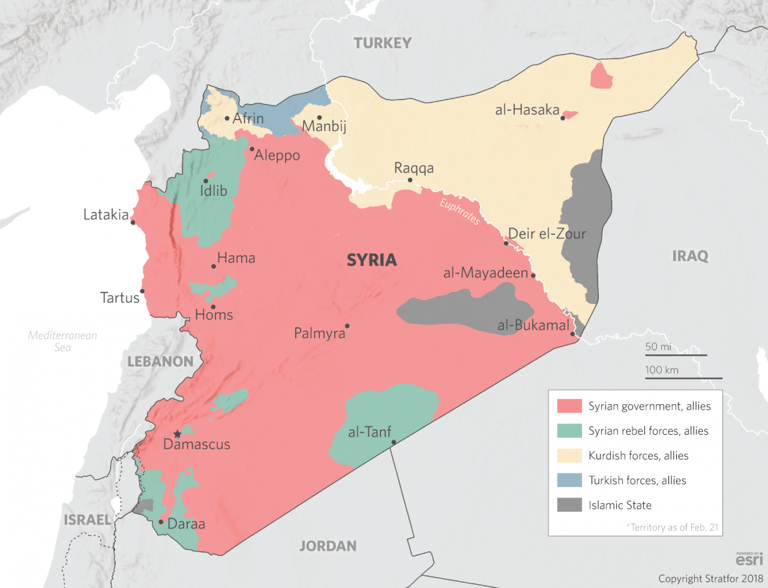

Regime Recapture (2017)
Assad’s forces, with support from Russia and Iran, had recaptured much of Syria, including Aleppo and Homs, though Idlib and parts of the northeast remain contested.
Idlib, the last major stronghold of opposition groups, remained under the control of various rebel factions, including groups like Hayat Tahrir al-Sham.
Kurdish-controlled areas in the northeast, largely governed by the Syrian Democratic Forces (SDF), remain a point of tension, particularly with Turkey.
End of Assad Regime (2024)
On 8 December 2024, the Assad regime collapsed during a major offensive by Syrian revolutionary forces. The offensive was spearheaded by Hay'at Tahrir al-Sham (HTS) and supported mainly by the Turkish-backed Syrian National Army as part of the ongoing Syrian civil war that began in 2011.
As a rebel coalition advanced towards Damascus, reports emerged that Bashar al-Assad fled the capital aboard a plane to Russia, where he joined his family, already in exile, and was granted asylum. Following Assad's departure, revolutionary forces declared victory on state television. This marked the end of 53 years of dictatorship in Syria by the father and son duo.
As of 2022 the civil war had killed around 580,000 people, of whom at least 306,000 were non-combatants. According to the Syrian Network for Human Rights, pro-Assad forces caused more than 90% of the civilian deaths. The Assad government perpetrated numerous war crimes during the course of the Syrian civil war, and Assad's army, the Syrian Arab Armed Forces, also carried out several attacks with chemical weapons. The deadliest chemical attack was a sarin gas strike in Ghouta on 21 August 2013, which killed between 281 and 1,729 people.
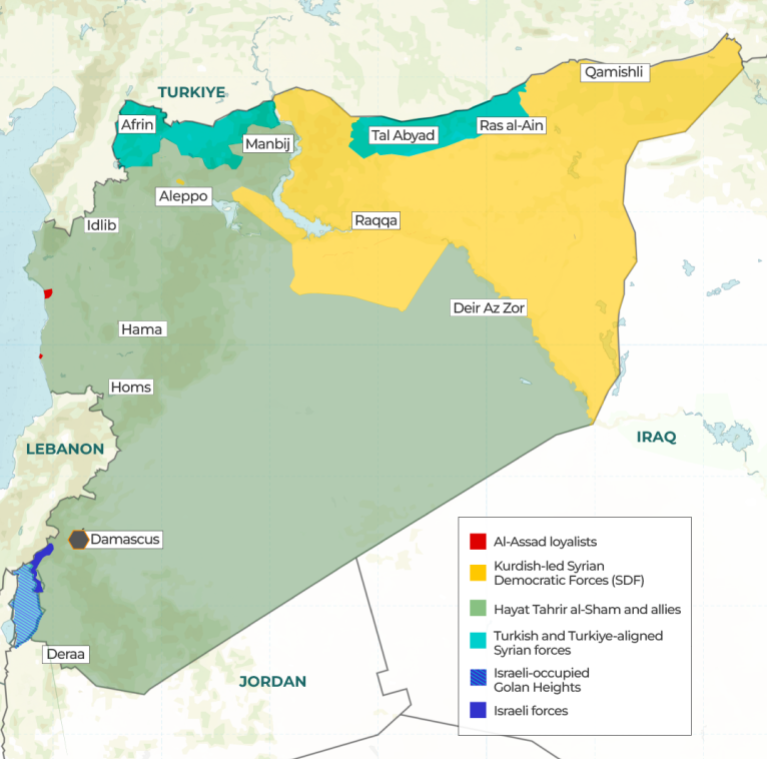

Sednaya Prison, nicknamed the "Human Slaughterhouse" was a military prison and death camp north of Damascus, Syria, operated by Ba'athist Syria. The prison was used to hold thousands of male prisoners, both civilian detainees and anti-government rebels as well as political prisoners. The Syrian Observatory for Human Rights (SOHR) estimated in January 2021 that 30,000 detainees were killed by the Assad regime in Sednaya from torture, ill-treatment and mass executions since the outbreak of the Syrian civil war, while Amnesty International estimated in February 2017 "that between 5,000 and 13,000 people were extrajudicially executed at Sednaya between September 2011 and December 2015."
What led to the Civil War?
1. Authoritarian Rule and Political Repression:
The Assad regime, led by President Bashar al-Assad, represented a deeply entrenched authoritarian government with limited political freedoms. Dissatisfaction with the regime's oppressive rule and lack of democratic reforms had been building for years. The government's brutal crackdown on protests and opposition forces further fueled discontent, leading to the violent escalation of the conflict.
2. Economic Issues:
Widespread poverty and unemployment, particularly among the youth, contributed to frustrations. Economic mismanagement, corruption, and a series of failed economic policies exacerbated the situation. In addition, the Syrian economy had been struggling for years due to a combination of drought, agricultural collapse, and rising food prices, which worsened the living conditions for many Syrians, particularly in rural areas.
3. Religious Inequality:
There was growing inequality between the country's various ethnic and religious groups. While the Alawite minority, to which Assad belongs, held much of the power, other groups, such as Sunnis, were marginalized, tortered and jailed for even criticising the Assad regime. The Assad regime killed thousands of Sunni muslims in Syria by just labeling them terrorists or terrorist sympathizers. This disparity fueled sectarian tensions, as the opposition was largely composed of Sunni Muslims, while Assad's government was backed by Alawites, Christians, and other minorities.
4. Arab Spring Influence:
The wave of protests and revolutions across the Arab world in 2011, known as the Arab Spring, inspired many Syrians to demand democratic reforms and greater political freedoms. In March 2011, a group of teenagers in the southern city of Daraa was arrested and tortured for writing anti-government graffiti, sparking mass protests. This led to widespread demonstrations that called for the end of Assad’s rule.
5. Sectarianism and Regional Tensions:
Syria's diverse population includes Sunni Muslims(74%), Alawites(13%), Christians(10%), Kurds(ethnic group), and Druze(3%), leading to tensions between these groups. The sectarian nature of the conflict was exacerbated by the involvement of regional powers such as Iran, Saudi Arabia, and Turkey, each supporting different factions based on sectarian or geopolitical interests.
6. Foreign Intervention:
Foreign powers played a major role in fueling the conflict, providing military and financial support to various factions. Iran and Russia backed the Assad regime, while the U.S., Saudi Arabia, and other Western countries supported opposition groups. The involvement of these powers not only prolonged the conflict but also turned it into a proxy war, with each side pursuing its own geopolitical goals.
Key Points
Alawites
Also known as Alawī or Nusayris, are a minority ethnoreligious group in Syria, constituting about 12-15% of the population, primarily residing in the coastal regions of Latakia, Tartus, and Homs. While they follow a sect within Shia Islam, their beliefs differ significantly from mainstream Shia Islam. Alawites believe in the divinity of Ali, the cousin of Prophet Muhammad, and view him as a physical manifestation of God. They also believe in reincarnation and seek spiritual enlightenment.
In the context of Sunni Islam, Alawites are considered heretics due to their deviant beliefs, especially their view of Ali as divine, which Sunni scholars label as Shirk.
In the context of Shia Islam, Alawites share reverence for Ali but diverge from mainstream Shia beliefs, particularly in their focus on Ali's divinity rather than the Twelve Imams. As a result, many Shia scholars do not accept Alawites as orthodox Shia Muslims.
HTS
Hay'at Tahrir al-Sham is a jihadist militant group primarily operating in northwestern Syria, particularly in Idlib. It was formed in 2017 from a merger of various factions, including the former Jabhat al-Nusra, which was aligned with Al-Qaeda. While HTS follows a Salafi-jihadist ideology, it has distanced itself from Al-Qaeda in recent years. This shift reflects HTS's "moderate jihad" strategy since 2017, emphasising pragmatism over rigid ideology. Abu Mohammad al-Julani, the group's leader, has played the central role in overthrowing of the Assad regime with the help of Turkey.
Aftermath
Interim Government
HTS leader Abu Mohammad al-Julani announced that Syrian public institutions would temporarily remain under Prime Minister Mohammad Ghazi al-Jalali until a political transition is completed. Al-Jalali expressed hope for a "normal" Syria and diplomatic relations. Al-Julani condemned Syria’s role in promoting Iranian interests and sectarianism. The next day, Mohammed al-Bashir was appointed as the new prime minister of the transitional government. HTS also promised to protect Christians and other minorities' religious freedoms.
Israeli Invasion
The Israel Defense Forces (IDF) launched a military invasion in Syria's Quneitra Governorate, marking the first time in 50 years Israeli forces crossed the Syrian border since the 1974 ceasefire. The IDF targeted areas like Tel Ayouba with artillery fire. PM Netanyahu declared the 1974 border agreement void after the Syrian Army abandoned its positions and ordered the IDF to re-occupy the Purple Line. Israel also conducted airstrikes on Khalkhala airbase, Mazzeh district, and other weapons sites to prevent weapons from falling into the hands of HTS.
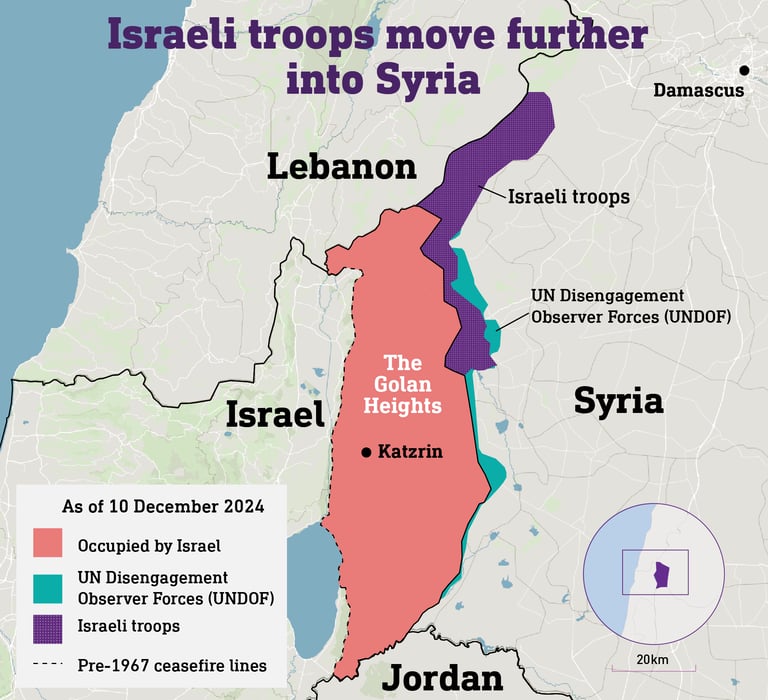

Kurdish Autonomy
The Syrian Democratic Forces (SDF) aim to establish an autonomous, decentralized region in northeastern Syria or an outright independence as part of an independent Kurdistan. Their goals include securing their territory from threats like ISIS and Turkish-backed forces, gaining political recognition, and advocating for equal rights for all ethnicities in Syria. They seek international support to achieve these objectives while opposing Syrian national unity and view Turkish alliance with HTS as hostile.
Tensions have escalated between Hay'at Tahrir al-Sham (HTS) and the Syrian Democratic Forces (SDF), particularly in northern Syria. Clashes have been reported near Manbij, with the SDF repelling HTS infiltration attempts, resulting in casualties on both sides.
Turkey is negotiating with Syria's new rulers and Kurdish leadership to prevent further conflict. The situation remains volatile, with concerns over a potential new civil war in Syria.
To be continued...
As new information emerges, I'll update this article.
Thanks for reading.
